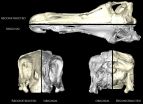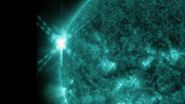(Press-News.org) For years, scientists have debated how best to assess brain levels of oxytocin, a hormone implicated in social behaviors. Now, researchers at the Stanford University School of Medicine have found the first direct evidence in children that blood oxytocin measurements are tightly linked to levels of oxytocin in cerebrospinal fluid, which bathes the brain.
Low oxytocin levels in blood and CSF are both correlated to high anxiety levels, the research also showed. The findings will be published online Nov. 4 in Molecular Psychiatry.
"So many psychiatric disorders involve disruptions to social functioning," said the study's senior author, Karen Parker, PhD, assistant professor of psychiatry and behavioral sciences. "This study helps scientifically validate the use of measuring oxytocin in the blood, and suggests that oxytocin may be a biomarker of anxiety. It raises the possibility that oxytocin could be considered as a therapeutic target across a variety of psychiatric disorders."
An invasive procedure
Collecting CSF requires an invasive lumbar puncture procedure, in which a needle is inserted into the space around the spine. To avoid this, scientists measure oxytocin in the blood, but they have been unsure how well these measurements reflected the hormone's levels in the central nervous system. The new study shows that, although oxytocin levels are consistently lower in blood than in CSF, the levels of the hormone in the two are linked.
To conduct the research, Parker's team sought volunteers from among a group of people who needed lumbar punctures for medical reasons. The study included 27 subjects ages 4-64. With the volunteers' consent, the researchers tested oxytocin levels in CSF obtained during the lumbar puncture. They collected blood samples at the same time that the CSF was obtained. In addition, the parents of 10 children enrolled in the study answered a questionnaire about the children's anxiety levels.
"The fact that we measured blood and CSF at the same time shows for the first time that there's a tight relationship between oxytocin levels in those two compartments [blood and CSF] and anxiety," said the study's lead author, Dean Carson, PhD, postdoctoral scholar in psychiatry and behavioral sciences.
Oxytocin levels were lower in the blood than in the CSF in all subjects, but the concentrations in the two compartments followed similar patterns: People with relatively low blood oxytocin also had low CSF oxytocin, while those with high levels of the hormone in one compartment also had high levels in the other. Low oxytocin levels were linked to higher anxiety scores.
In autistic children, varying oxytocin levels
"I was amazed by how beautiful the data looked," Parker said, noting that the correlations between oxytocin and anxiety were surprisingly strong for a small study, and provide interesting fodder for future research. "I think it opened up a lot more doors."
For instance, Carson and Parker want to know whether oxytocin could treat anxiety in some kids with autism. Social anxiety affects 80-90 percent of children with autism, Parker noted. Recently published research by her team showed that oxytocin levels vary in children with autism, which hints that different children may derive different levels of benefit from oxytocin therapy.
"Our belief is that there are oxytocin responders and nonresponders," Carson said, adding that the team is now testing this hypothesis.
The research provides hope for a future in which there will be less guesswork in treating psychiatric disease. "Being able to have objective measures of psychiatric illness really will enhance early diagnosis and measures of treatment outcomes," Carson said.
The team also wants to see if links between oxytocin and anxiety are limited to social anxieties, or if they could apply to nonsocial fears, such as a phobia of spiders.
"This research is a first look into an interesting set of questions," Carson said. "They need to be further investigated in more tightly controlled populations."
INFORMATION:
The paper's other Stanford co-authors are Sean Berquist, a former social science research assistant; undergraduate students Tara Trujillo, Raena Sumiyoshi and Lisa Jackson; Joseph Garner, PhD, associate professor of comparative medicine; Sadie Hannah, nurse practitioner in pediatric oncology; Shellie Hyde, laboratory manager in psychiatry; Jacob Moss, a former lab assistant; Matthew Strehlow, MD, clinical associate professor of surgery; Samuel Cheshier, MD, PhD, assistant professor of neurosurgery and a pediatric neurosurgeon at Lucile Packard Children's Hospital Stanford; Sonia Partap, MD, clinical assistant professor of neurology and neurological sciences and a pediatric neuro-oncologist at the hospital; and Antonio Hardan, MD, professor of psychiatry and behavioral sciences and a child and adolescent psychiatrist at the hospital.
Hardan and Parker are members of Stanford's Child Health Research Institute.
The research was funded by an Autism Speaks Meixner Postdoctoral Fellowship in Translational Research, a Stanford School of Medicine Dean's Postdoctoral Fellowship, the Katherine D. McCormick Fund, the Mosbacher Family Fund for Autism Research, Stanford's Bio-X NeuroVentures Program, the Weston Havens Foundation, and by an National Institutes of Health/National Center for Research Resources grant to the Stanford Center for Clinical Informatics (grant UL1RR025744).
Information about Stanford's Department of Psychiatry and Behavioral Sciences, which also supported the work, is available at http://psychiatry.stanford.edu.
The Stanford University School of Medicine consistently ranks among the nation's top medical schools, integrating research, medical education, patient care and community service. For more news about the school, please visit http://med.stanford.edu/school.html. The medical school is part of Stanford Medicine, which includes Stanford Health Care and Lucile Packard Children's Hospital Stanford. For information about all three, please visit http://med.stanford.edu.
Print media contact: Erin Digitale at (650) 724-9175 (digitale@stanford.edu)
Broadcast media contact: Becky Bach at (650) 724-2454 (retrout@stanford.edu)
Oxytocin levels in blood, cerebrospinal fluid are linked, Stanford study finds
2014-11-04
ELSE PRESS RELEASES FROM THIS DATE:
Digital dinosaurs: New research employs high-end technology to restore dinosaur fossil
2014-11-04
Fossils are usually deformed or incompletely preserved when they are found, after sometimes millions of years of fossilization processes. Consequently, fossils have to be studied very carefully to avoid damage, and are sometimes they are difficult to access, as they might be located in remote museum collections. An international team of scientists, led by Dr. Stephan Lautenschlager from the University of Bristol now solved some of these problems by using modern computer technology, as described in a recent issue of the Journal of Vertebrate Paleontology.
The team consisting ...
Nonobstructive CAD associated with increased risk of heart attack, death
2014-11-04
In a study that included nearly 38,000 patients, those diagnosed with nonobstructive coronary artery disease (CAD) had a significantly increased risk of heart attack or death one year after diagnosis, according to a study in the November 5 issue of JAMA.
Nonobstructive coronary artery disease (CAD) is atherosclerotic plaque that would not be expected to obstruct blood flow or result in anginal symptoms (such as chest pain). Although such lesions are relatively common, occurring in 10 percent to 25 percent of patients undergoing coronary angiography, their presence has ...
Combination treatment for metastatic melanoma results in longer overall survival
2014-11-04
Among patients with metastatic melanoma, treatment with a combination of the drugs sargramostim plus ipilimumab, compared with ipilimumab alone, resulted in longer overall survival and lower toxicity, but no difference in progression-free survival, according to a study in the November 5 issue of JAMA.
F. Stephen Hodi, M.D., of the Dana-Farber Cancer Institute, Boston, and colleagues conducted a phase 2 clinical trial in which 245 patients with unresectable (unable to be removed by surgery) stage Ill or IV melanoma were randomly assigned to receive ipilimumab (intravenously) ...
Study finds Google glasses may partially obstruct peripheral vision
2014-11-04
Testing of study participants who wore head-mounted display systems (Google glasses) found that the glasses created a partial peripheral vision obstruction, according to a study in the November 5 issue of JAMA.
Interest in wearable head-mounted display systems for general consumers is increasing, with multiple models in production. However, their effect on vision is largely unknown. Peripheral visual field is a main component of vision and essential for daily activities such as driving, pedestrian safety, and sports. Conventional spectacle frames can reduce visual field, ...
Immune booster combined with checkpoint blocker improves survival in metastatic melanoma
2014-11-04
BOSTON – Patients with metastatic melanoma who were treated with ipilimumab, an immune checkpoint blocker, survived 50 percent longer – a median 17.5 months vs. 12.7 months – if they simultaneously received an immune stimulant, according to a study led by Dana-Farber Cancer Institute scientists.
Patients in the clinical trial who got the combined therapies also had fewer serious adverse side effects than those who received only ipilimumab, the researchers report in the Journal of the American Medical Association.
The group treated with both ipilimumab ...
Long-acting anti-meth treatment demonstrates protective benefits for meth addiction
2014-11-04
San Diego — A recently developed Adeno-Associated Virus (AAV)-based medication has the potential to offer substantial protective effects for patients attempting to cease methamphetamine use. This research is being presented at the 2014 American Association of Pharmaceutical Scientists (AAPS) Annual Meeting and Exposition, the world's largest pharmaceutical sciences meeting, in San Diego, Nov. 2-6.
Methamphetamine, commonly referred to as meth, is an addictive substance that can cause brain damage, organ failure, stroke, open sores, rotting teeth, mania, paranoia, ...
Novel nanofiber-based technology could help prevent HIV/AIDS transmission
2014-11-04
San Diego — Scientists have developed a novel topical microbicide loaded with hyaluronic acid (HA) nanofibers that could potentially prevent transmission of the human immunodeficiency virus (HIV) through the vaginal mucosa. This research is being presented at the 2014 American Association of Pharmaceutical Scientists (AAPS) Annual Meeting and Exposition, the world's largest pharmaceutical sciences meeting, in San Diego, Nov. 2-6.
HIV is an infectious virus that attacks T lymphocytes, a type of white blood cell that prevents infections and disease. Over time, HIV ...
Medicare may need to expand options for behavioral weight loss counseling in primary care
2014-11-04
PHILADELPHIA – An important addition to the "eat less, move more" strategy for weight loss lies in behavioral counseling to achieve these goals. But research on how primary care practitioners can best provide behavioral weight loss counseling to obese patients in their practices — as encouraged by the Centers for Medicare and Medicaid Services (CMS) — remains slim, according to a systematic review of this topic published today in JAMA. The study was led by researchers from the Perelman School of Medicine at the University of Pennsylvania.
"After an ...
Autism spectrum disorder: 10 tips guidance article
2014-11-04
Washington D.C., November 4, 2014 – A Clinical Perspectives article published in the November 2014 issue of the Journal of the American Academy of Child and Adolescent Psychiatry proposes a tool to empower stakeholders, guide caregivers, and provide a rationale for advocates, when considering the systems of support offered to people with an autism spectrum disorder (ASD).
Organizations such as the American Academy of Child and Adolescent Psychiatry, the European Society for Child and Adolescent Psychiatry, the International Association for Child and Adolescent Psychiatry ...
NASA's SDO sees a mid-level solar flare: Nov. 3
2014-11-04
The sun emitted a mid-level solar flare, peaking at 5:40 p.m. EST on Nov. 3, 2014. NASA's Solar Dynamics Observatory, which watches the sun constantly, captured an image of the event. Solar flares are powerful bursts of radiation. Harmful radiation from a flare cannot pass through Earth's atmosphere to physically affect humans on the ground, however -- when intense enough -- they can disturb the atmosphere in the layer where GPS and communications signals travel.
To see how this event may affect Earth, please visit NOAA's Space Weather Prediction Center at http://spaceweather.gov, ...


